Roberta McHatton, Laser Safety Services
“Laser Safety Considerations for Industrial Environments,” by Laser Safety Solutions’ Ken Barat, published in the April 2015 issue of Industrial Photonics, notes that accessible emission of high-powered lasers (Class 3b and Class 4) is always done behind closed, locked doors and/or barriers that prevent human access whenever the lasers are emitting. Yet laser light shows use high-powered lasers in an open beam path setting, which can pose a risk to the general public who attend lasers shows and displays, often in large numbers and at a wide variety of venues. In no other laser application is the public ever likely to be exposed to laser radiation, thanks to adherence to the safety standards outlined in ANSI Z136.1, and regulations established by the Center for Devices and Radiological Health (CDRH), a branch of the U.S. Food and Drug Administration.
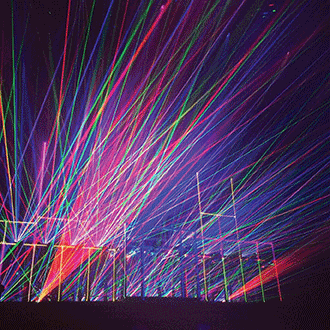
3-W Beam Burst RGB lasers from ER Productions are shown in grating mode during a concert in London; five 6-W scanning lasers were used to map the set. All images are courtesy of ER Productions.
The challenge for the laser show entertainment and display industry is to mitigate all possible risk to operators and crews, as well as to the general public. Potential hazards they must consider are injury to environment and to personnel. Laser show safety, done correctly, means adhering to specific requirements and recommendations as set forth in national and international safety standards such as ANSI and IEC.
ANSI is now developing a new standard: ANSI Z136.10 Safe Use of Lasers in Entertainment, Display and Tradeshows. IEC 60825-3 Safety of Laser Products
is also undergoing extensive review this year.
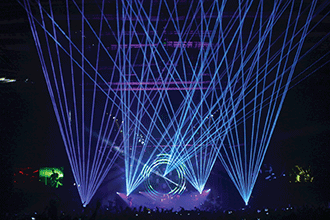
Five 21-W scanning lasers, projecting into the air during a show in London. Four 6-W scanning lasers were used to map the circles of the set.
Dangers of show lasers
Lasers have been classified by wavelength and maximum output power into four classes and a few subclasses since the early 1970s. The classifications categorize lasers according to their ability to produce damage in exposed people, from Class 1 (no hazard during normal use) to Class 4 (severe hazard for eyes and skin). Laser classification is determined from maximum power (in W) or energy (in J) that can be emitted in a specified wavelength range and exposure time that passes through a specified aperture stop at a specified distance. Classification results are based on the maximum permissible exposure. Safety requirements and recommendations are based on classification and control measures.
With rare exceptions, if you can see a laser beam (larger than a dot on the floor or wall) you can assume it is a Class 3b or Class 4 laser system. Class 4 lasers require the most control measures with the goal of eliminating all risk of human exposure. Class 3b and Class 4 lasers are not usually considered safe for use in an open beam path setting because there is risk of serious biological injury, particularly relating to the eye.
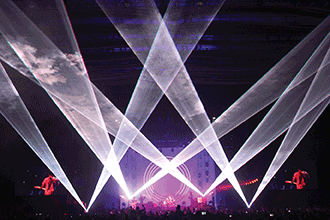
Five 21-W scanning lasers, projecting into the air during a show in London. Four 6-W scanning lasers were used to map the circles of the set.
Additional concerns became apparent when lasers were first being used in airspace, posing unique concerns for air traffic, such as flash blindness and startle response. When a Class 4 laser beam hits a windshield, the light blooms brightly, blinding pilots. Thanks to quick reporting and ability to triangulate locations, there has been some success in apprehending those responsible for improper laser use. Now, laser show producers notify the
Federal Aviation Administration in advance.
Because of the potential danger of Class 3b and Class 4 lasers to humans, the CDRH requires anyone wishing to operate a Class 3b or Class 4 laser in an open beam path environment to apply for a variance from the regulatory requirements, as established in Code of Federal Regulations 1040.10 Laser Products. Very specific guidelines are given in a variance that laser show producers must follow. This should be of comfort to anyone attending a laser show or display in the U.S. However, the purchasers who buy lasers online from another country are often unaware of the federal regulations and, if they are aware, become discouraged with the application process.
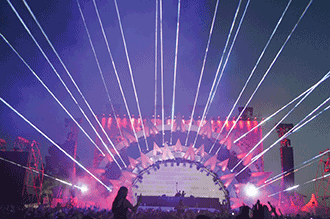
Thirty 3-W Beam Burst lasers are pictured here in beam mode during a performance at the Future Music Festival in Australia.
Audience exposure and scanning poses unique challenges and opportunities by providing cutting-edge effects to audiences already engaging in higher than normal risk activities, such as high-volume music and alcohol consumption. Common methods of intentional audience exposure techniques include increasing beam divergence, relying on scan fail-safe devices and diffraction gratings.
A 1997 study from the 1997 International Laser Safety Conference Proceedings found only five reported accidents (eye injuries) in the first 20 years of audience-scanning laser shows. The study noted that there was likely underreporting, but even if nine out of 10 accidents do not become public, this means there were roughly 25 injuries per decade, worldwide. This is surprisingly low compared to injury rates for other entertainment-related activities. For example, a U.S. Consumer Product Safety Commission study found that amusement park ride incidents caused roughly 72,000 injuries and 44 fatalities over a decade in the U.S. alone.
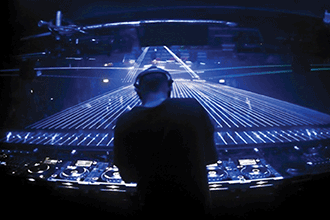
Eight blue lase-arrays (10 parallel, 100-MW beams) projecting above the audience at Austria’s Snowbombing Festival.
Laser show safety in practice
The laser show provider assigns a Laser Safety Officer to establish a laser safety program designed to address all the possible risks of using lasers in open beam path settings; procedural control measures, including use of the laser system’s lowest power setting possible for alignment and zoning, must also be set.
Engineering controls are always the preferred method of risk mitigation. Projectors are required to have emission indicators that light up when a laser is active and interlock switches to prevent lasers from firing if the projector housing is opened. Each projector must have proper labeling, such as a warning label at aperture to warn against looking into the aperture. Once laser systems are mounted properly, the beams must be tuned to where they will be propagated during the show, avoiding areas that could directly hit audience members.
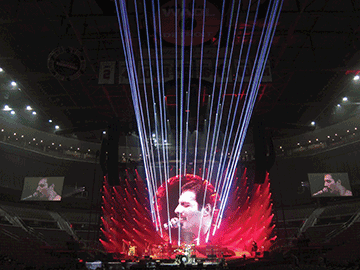
Featured during the Queen + Adam Lambert world tour are twenty-four 3-W Beam Burst lasers, pictured here in beam mode.
New technology is the game changer. IR cameras and motion sensors have been implemented as added control measures for manned and unmanned laser entertainment applications. Scanner speeds and reliability, diffraction grating and coatings, and optical fibers that hold up to high-power lasers, as well as new software innovations, such as the Swiss Federal Institute of Metrology’s LASRA real time assessment tool, provide safer solutions in this constantly evolving industry.
Meet the author
Roberta McHatton is a laser safety officer and consultant, and owner of Laser Safety Services in Sumner, Wash.; email: roberta@lasersafety
services.com.